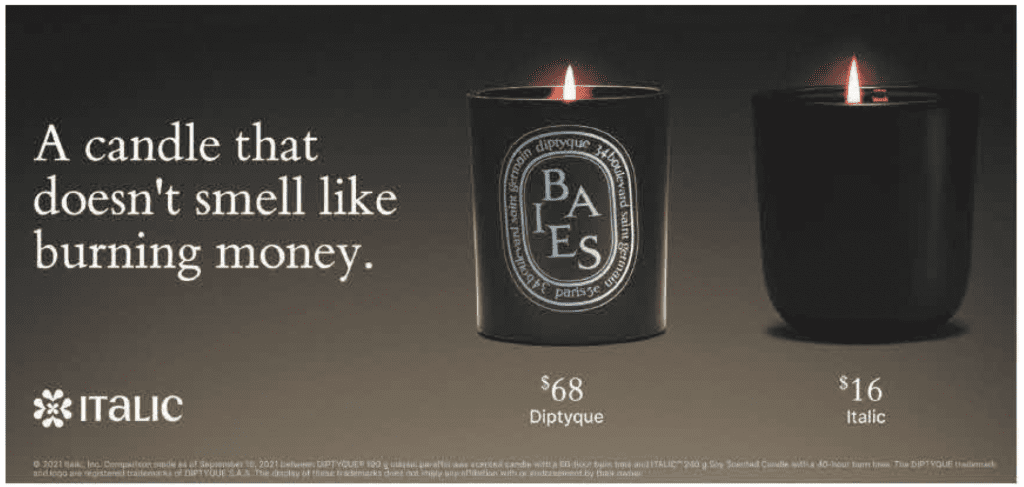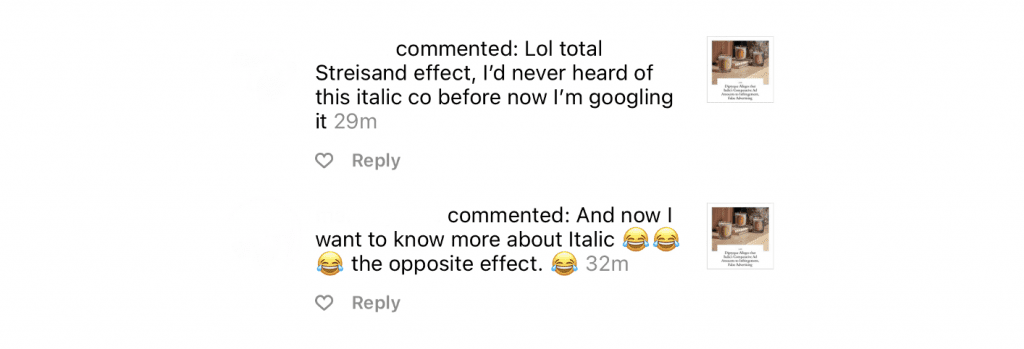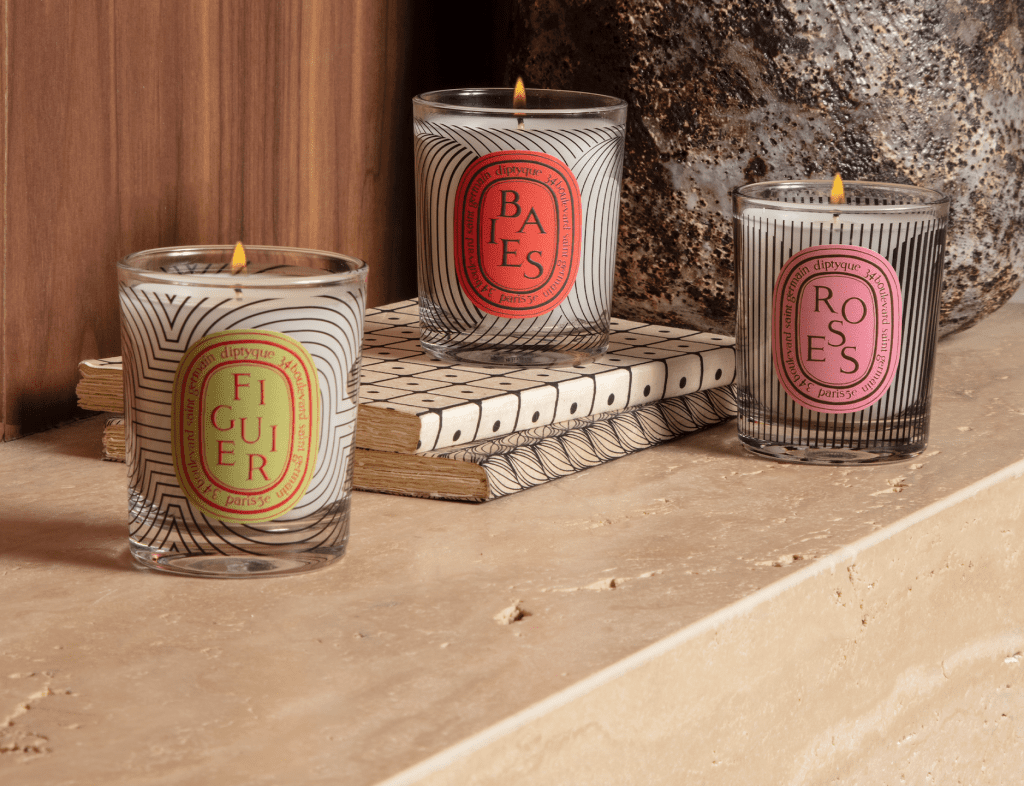Diptyque is taking aim at Italic, accusing the swiftly-growing retail startup of running afoul of both federal and state law by way of a new advertising campaign that endeavors to compare the two parties’ candles, but that allegedly fails to do so in a way that is either necessary or truthful, and instead, which “comprises a series of false statements and depictions” all in furtherance of a quest by tech founder (and former Thiel Fellow) Jeremy Cai’s company to piggyback on the cult appeal of the 60-year-old Diptyque brand.
According to the complaint that it filed in a California federal court on Monday, Diptyque asserts that Italic recently launched an ad campaign – both online and on billboards in New York and Los Angeles – that pictures its $16 unbranded candle alongside a $68 Diptyque Bais candle. In connection with the recently-released “compare to Diptyque” campaign, the Parisian fragrance company claims that Italic is attempting to “imply parity between Diptyque’s scented candles and Italic’s scented candles […] when in fact the two candles being compared are not commensurate in size, burn rate, content, fragrance concentration, potency, and other variables that make Diptyque candles superior and more desirable.”
Italic also allegedly pushes viewers towards its own offerings by including the text, “A candle that doesn’t smell like burning money,” in bold alongside both parties’ offerings.
Comparative Advertising
In order for comparative advertising to be permitted under both federal and state laws, Diptyque asserts that the advertisement must be “truthful and honest regarding the products compared and their respective benefits,” which it argues is not the case here. Specifically, Diptyque claims that the Bais candle portrayed in Italic’s ad is “not accurate, with regard to its size, burn rate, or its price, and the candle image has been altered in at least size and color.” At the same time, “The price of the comparative Italic candle is not accurate either, in that it represents Italic ‘member pricing,’ which includes a $60 annual fee.”
Italic “attempts to reconcile some of these issues in mouse-print disclaimers, which would not be legible to consumers on any billboard,” but Diptyque argues that even those disclaimers are “inaccurate as to the burn rate and size of the Diptyque candle portrayed in the advertisement.”

Things run further afoul of the law, as “comparative advertising also requires that the advertiser not disparage or tarnish the allegedly competing product,” which counsel for Diptyque argues is precisely what Italic is doing here. “Italic’s billboard tagline ‘A candle that doesn’t smell like burning money’ jabs at the primary feature of Diptyque’s candles – their fragrance – to baselessly convey to consumers that Diptyque’s high-end candles are, at best, a rip-off, and at worst, a fraud.”
And finally, even if Italic ads did not include erroneous information, the almost 4-year-old company would still be in the wrong, according to Diptyque, as “it was unnecessary for [it] to use Diptyque’s instantly recognizable oval design logo, and to manipulate the appearance of Diptyque’s candle and otherwise disparage the Diptyque brand” in the ad campaign. This is problematic, as “in the context of trademark and other intellectual property rights, comparative advertising requires [… ] that the advertiser use only so much of the mark or marks as is reasonably necessary to identify the product or service.”
Instead of limiting its use of Diptyque’s “logo trademarks and copyrights,” Italic allegedly opted to use them in full “as a means to trade on Diptyque’s substantial goodwill, and use the well-known trademarks and copyright of a market leader to capture consumers’ attention for its own product – and in large-scale billboard form,” the famed candle company claims. As for what those trademarks and copyright consist of, Diptyque points to its incontestable federal registrations in the DIPTYQUE word mark, and a word and design mark that consists of “34 BOULEVARD SAINT GERMAIN DIPTYQUE PARIS5E, [and which] depicts the words inside an oval shape.” Diptyque also makes mention of its consistent use of “jumbled and stacked letters that appear inside its Oval Mark,” which is both “striking and very much associated with Diptyque.”
The company asserts that it has a copyright registration for the specific depiction of the jumbled BAIES design inside of the oval (although it is not entirely clear to me how an infringement claim is particularly relevant here), and maintains common law trademark rights for it, as well.
Italic’s use of “identical copies and colorable imitations of” Diptyque’s trademarks in advertisements that “promote its inferior goods” is likely to cause confusion, or to cause mistake, or to deceive consumers as to association of Italic with Diptyque when no such affiliation exists, the candle-maker contends. Moreover, Diptyque argues that Italic’s conduct “literally and impliedly false or materially misleading statements to consumers, constituting unfair competition and false advertisement in violation of the Lanham Act, in that Italic has published false or necessarily implied false and misleading statements that are likely to deceive consumers and direct them away from purchasing or otherwise using Diptyque’s products and instead purchase products from Italic.”
With this in mind, Diptyque sets out claims of false advertising, unfair competition, trademark infringement, and copyright infringement, and is seeking an unspecific sum of damages, as well as injunctive relief to permanently bar Italic from further infringing its rights and making false statements in connection with Diptyque’s brand or products, among other things.
The Big Issue
What ultimately appears to be at issue in the case is Italic’s alleged attempt to trade on the appeal of another brand in order to sell its own goods. As Diptyque argues in its complaint, Italic’s ad comes in furtherance of its larger business and marketing strategy, in furtherance of which it “claims to have ‘eliminated traditional brand and retail markups’ which allows its customers to ‘pay 50-80% less for the exact same quality.’” In other words, the budding young company’s model depends (or at least has depended in the past), in large part, on the appeal of high-end brands’ offerings.
Interestingly enough, the lawsuit comes after Italic has undergone what appears to be a shift in how it presents its products, moving away from a more aggressive attempt to align itself with certain high fashion and luxury brands. As TFL noted back in 2018, Italic has long argued that “by removing brands and labels from the equation,” it enables “manufacturers to earn significantly higher profits while passing ‘brand markup’ savings onto customers.” Yet, it was simultaneously making prominent mentions of other brands in connection with its own offerings: “Cream made from the same ingredients as La Mer,” read one prompt on its website. A bag was advertised elsewhere on its site as being made by suppliers in a factory that “previously produced luxury handbags for Celine.”
Founder and CEO Jeremy Cai noted at the time that his company was, in fact, being “a little controversial in that we say, ‘Here is a handbag made in the same factory as Prada.’” (Worth pondering: Could this possibly be part of a larger effort to garner publicity for the brand in the same way as MSCHF, for instance, has been taunting companies like Hermès, Disney, Nike, etc. to file suit against it? Comments on TFL’s Instagram are interesting in this regard.)

TFL previously questioned whether Italic was really removing brands from the equation when it was making such overt mentions of other brands and seemingly looking to directly associate its wares to those of some of fashion’s most well-known brands. Such prominent mentions were significant (in my mind), as it was not impossible to image any of those protective luxury brands arguing that Italic was making use of their trademark-protected names in an effort to entice consumers to buy its own products.
Chances are, Italic – which has attracted investors like Comcast Ventures, Global Founders Capital, Index Ventures, Ludlow Ventures, and Kindred Ventures, among others, and raised at least $13 million over four rounds – may have been able to shield itself by way of fair use arguments if faced with litigation from any of those brands. (I have not seen any such cases being filed.) Yet, the company appears to be playing it a bit safer now, at least on some fronts. It still informs consumers that its bags, for example, are made in factories that boast “past clients” like Miu Miu and Prada; that its eyewear comes from factories that used to manufacture glasses for Chanel; and that its outerwear is made by suppliers that counted have Armani and Max Mara as clients. However, these facts are presented in a way that is far less centrally located and less bold than in the past.
Nonetheless, while it may have toned down its references to other brands on its site, Italic has ruffled Diptyque’s feathers on the advertising front just as the company – which has largely operated using a membership model to date – has announced that consumers can shop its markup-free offerings without paying for a membership.
A rep for Italic did not immediately respond to a request for comment.
UPDATED (Nov. 8, 2021): The parties seem to have swiftly settled their differences, as counsel for Diptyque filed a Notice of Voluntary Dismissal, thereby, bringing the case to a close. The dismissal is without prejudice, though, meaning that the upscale candle co. may initiate a separate suit against Italic on the same grounds in the future in the case whatever terms that the parties reached in order to settle the matter do not come into fruition.
The case is Diptyque SAS, et al v. Italic, Inc., 2:21-cv-08227 (C.D.Cal.)











